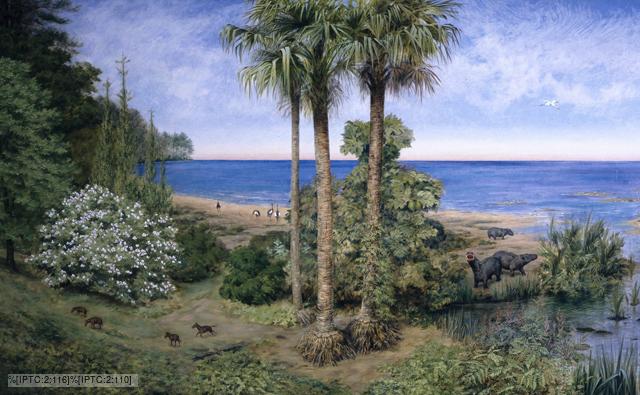 |
| Eocene, by Natural History Museum London |
The early Eocene epoch (56 to 48 million years ago), is thought to be the warmest period on Earth in the past 65 million years. Geological evidence from this epoch indicates that the polar regions were very warm, with mean annual sea surface temperatures of > 25°C measured from geological proxies and evidence of a wide variety of vegetation including palm trees and insect pollinated plants found on land. Unfortunately, geological data from the tropics is limited for the early Eocene, although the data that does exist indicates temperatures only slightly warmer than the modern tropics, which are ~28°C. The reduced temperature difference between the tropics and the poles in the early Eocene and the implied global warmth has resulted in the label of an ‘equable’ climate.
Simulating the early Eocene equable climate with climate models, however, has not been straightforward. There have been remarkable model-data differences with simulated polar temperatures are too cool and / or tropical temperatures that are too hot; or the CO2 concentrations used for a reasonable model-data match being outside the range of those measured for the early Eocene.
There are uncertainties in both geological evidence and climate models, and whilst trying to resolve the early Eocene equable climate problem has resulted in an improved understanding of geological data, there are uncertain aspects of climate models that still need to be examined. Climate processes for which knowledge is limited or measurements are difficult, such as clouds, or which have a small spatial and temporal range are often simplified in climate models or parameterised. These uncertain model parameters are then tuned to best-match the modern observational climate record. This approach is not ideal, but it is sometimes necessary and it has been shown that the modern values of some parameters, such as atmospheric aerosols, may not be representative of past climates such as the early Eocene, with their removal improved the model-data match.
However, a climate model that can simulate both the present day climate and past more extreme climates without significant modification potentially offers a more robust method of understanding modern and future climate processes in a warming world. We have conducted research in which uncertain climate parameters are varied within their modern upper and lower boundaries in order to examine whether any of these combinations is capable of the above. And we have found one simulation, E17, from a total of 115, which simulates the early Eocene equable climate and improves the model-data match whilst also simulating the modern climate and a past cold climate, the last Glacial Maximum reasonably well.
This work hopefully highlights how paleoclimate modelling is a valuable tool in understanding natural climate variability and how paleoclimates can provide a test bed for climate models, which are used to predict future climate change.
